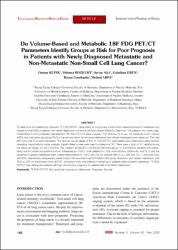| dc.contributor.author | Kupik, Osman | |
| dc.contributor.author | Bozkurt, Mehmet | |
| dc.contributor.author | Asa, Sertaç | |
| dc.contributor.author | Eren, Gülnihan | |
| dc.contributor.author | Gündoğdu, Hasan | |
| dc.contributor.author | Arpa, Medeni | |
| dc.date.accessioned | 2020-12-19T19:35:17Z | |
| dc.date.available | 2020-12-19T19:35:17Z | |
| dc.date.issued | 2020 | |
| dc.identifier.citation | Kupik, O., Bozkurt, M., Asa, S., Eren, G., Gündoğdu, H. & Arpa, M. (2020). Do Volume-Based and Metabolic 18F FDG PET/CT Parameters Identify Groups at Risk for Poor Prognosis in Patients with Newly Diagnosed Metastatic and Non-Metastatic Non-Small Cell Lung Cancer?. Uhod-Uluslararasi Hematoloji-Onkoloji Dergisi, 30(3), 162-170. https://doi.org/10.4999/uhod.204173 | en_US |
| dc.identifier.issn | 1306-133X | |
| dc.identifier.uri | https://doi.org/10.4999/uhod.204173 | |
| dc.identifier.uri | https://hdl.handle.net/11436/1264 | |
| dc.description | WOS: 000574549000007 | en_US |
| dc.description.abstract | To determine the relationship between F-18 FDG PET/CT parameters of the primary tumor/nodal metastasis/distant metastasis and overall survival (OS) of patients with newly diagnosed non-small cell lung cancer (NSCLC). Data from 159 patients with newly diag-nosed NSCLC who underwent pretreatment 18F FDG PET/CT were analyzed. the SUVmax, SUVmean, the metabolic tumor volume (MTV), and total lesion glycolysis (TLG) of the primary tumor, lymph node metastasis, and distant metastasis were measured. the total MTV and total TLG were calculated. the optimal cut-off values of the F-18 FDG PET/CT parameters were determined using receiver operating characteristics curve analysis. Kaplan-Meier curves were used to determine OS. There were a total of 101 deaths during the follow-up (range, 3.7-54.2 months). the median OS was 26.4 months for the entire group, 11.8 months for patients with metas-tasis, and 41 months for patients with no metastasis (p< 0.001). in all patients (n= 159), nodal SUVmax (SUVmaxN), total TLG, and the presence of distant metastasis were independent predictors. the 2-year OS for patients with TLG >= 328 and TLG < 328 were 32% and 80%, respectively. Independent predictors for OS were found as SUVmaxN in the group of patients with distant metastasis, and SUVmax, MTV of the primary tumor (MTVT), and lymph node size (LNsize) in the group of patients without distant metastasis. F-18 FDG PET/CT may distinguish patients with high risk for poor prognosis in patients with and without metastasis. | en_US |
| dc.language.iso | eng | en_US |
| dc.publisher | Akad Doktorlar Yayinevi | en_US |
| dc.rights | info:eu-repo/semantics/openAccess | en_US |
| dc.subject | F-18 FDG PET/CT | en_US |
| dc.subject | Non-small cell lung cancer | en_US |
| dc.subject | Metastasis | en_US |
| dc.subject | Prognosis | en_US |
| dc.subject | Survival | en_US |
| dc.title | Do volume-based and metabolic 18F FDG PET/CT parameters identify groups at risk for poor prognosis in patients with newly diagnosed metastatic and non-metastatic non-small cell lung cancer? | en_US |
| dc.type | article | en_US |
| dc.contributor.department | RTEÜ, Tıp Fakültesi, Dahili Tıp Bilimleri Bölümü | en_US |
| dc.contributor.institutionauthor | Kupik, Osman | |
| dc.contributor.institutionauthor | Gündoğdu, Hasan | |
| dc.contributor.institutionauthor | Arpa, Medeni | |
| dc.identifier.doi | 10.4999/uhod.204173 | |
| dc.identifier.volume | 30 | en_US |
| dc.identifier.issue | 3 | en_US |
| dc.identifier.startpage | 162 | en_US |
| dc.identifier.endpage | 170 | en_US |
| dc.ri.edit | oa | en_US |
| dc.relation.journal | Uhod-Uluslararasi Hematoloji-Onkoloji Dergisi | en_US |
| dc.relation.publicationcategory | Makale - Uluslararası Hakemli Dergi - Kurum Öğretim Elemanı | en_US |


















